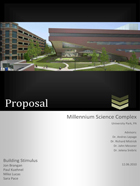Proposal
|
Structural Depth 1
The application of a double-skin fašade allows a unique opportunity for all disciplines to work closely on a specific system of the building. The structural engineer will be devoting the majority of his work regarding the fašade to the redesign of the pre-cast concrete panels. The panels will be designed for applicable lateral and gravity loads and ease of construction. Uniformity of panels across the varying facade and weight of the panels will be of high priority to reduce material and fabrication costs.
Structural Depth 2
The proposed redesign of the structural system will revolve around the design of the trusses supporting the 150-ft cantilever. The intent of the redesign is to switch the bracing of the trusses from compression to tension loading. Additionaly, the truss system will be increased above the current roof level and possibly extended an additional bay beyond the where the cantilever begins to span unsupported. This will increase the stiffness of the vertical truss supporting the cantilever while reducing the length of the structure that is unsupported. The end goal of this exploration into the design of the cantilever system is to design the truss for an efficient load path and optimize the constructability of the structure.
MAE Course Related Study
To fulfill MAE requirements for BIM Thesis, material explored in both Computer Modeling of Building Structures and Steel Connections will be used to complete the structural analysis of the Millennium Science Complex. ETABS and SAP 2000 will be used to model the lateral system of the building to perform a lateral system check for the redesigned structural system. Specifically the methods of placing rigid end offsets and panel zone analysis will be carried out for a thorough analysis of the cantilever. Also, steel connections will be redesigned where applicable to accommodate tension loading and different member shapes/sizing using the knowledge learned in the Steel Connections course.

